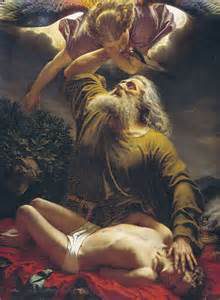
Vayeshev means “and he dwelled.” This portion opens with the amazing story of Joseph, starting with his being sold into slavery to Midianite traders who in turn sell him in Egypt. The parsha then interrupts the Joseph story with the account of Judah and Tamar, but then resumes talking about Joseph first being tempted by his master’s wife only to have his abstinence backfire and land him in prison. Once there, Joseph’s intellect gets him noticed and he makes prophecies that come true for two prisoners, the baker and the wine taster. The baker is killed but the wine taster was prophesied to go free but reneged on his promise to put in a good word for Joseph immediately upon his release.
Vayishlach means “and he sent” and once again the ‘he’ is Jacob sending messengers ahead with gifts in an attempt to reconcile with Esau, and what follows is for me, bar none, the greatest apology EVER given in Scripture. After that we get the tragic story of Dinah and Shechem where he rapes her and, even though he later wishes to make it right by marrying her, the sons of Israel exact revenge anyway. This is followed by a rather unique wrestling match—in this corner, the cunning man of Canaan, Jacob! And in that corner-uh-Yeshua the Messiah! Guess who wins? The parsha ends by giving Esau’s extensive descendant list.
Vayetze means “and he departed” the ‘he’ being Jacob heading towards Haran. At Haran
Jacob has his famous vision of the heavenly ladder before proceeding to dwell with his
uncle Laban. This of course sets up the struggle with Jacob wanting Rachel but being
forced to marry Leah as he toils for twenty years. After finally escaping, Jacob finds
himself trapped between a deceptive uncle he left behind and a brother who publicly
swore to kill him coming towards him with hundreds of armed men.
Toldot means “generations” or “family records,” referring to the lineage of Isaac. The troubled sibling rivalry of Jacob and Esau is the focus here. Jacob will eventually steal Esau’s birthright and blessing before running away. But as crafty as Jacob is he will find his uncle Laban even more deceitful and it is Laban who will outmaneuver Jacob for 20 years before Jacob gains advantage again. We also have the third occurrence—this time with Isaac and Abimelech II—of a wife (Rebecca this time) being passed off as a “sister” because a patriarch was afraid for his life. The portion ends with Esau taking another wife.
Chayei Sarah means “life of Sarah” but ironically it begins with her death! The full meaning actually is “the Life of Sarah WAS.” In the wake of her death, Abraham must find an appropriate place to bury his wife. Ephron the Hittite first offers some land to Abraham for free, but Abraham insists on paying (actually OVERPAYING according to the rabbis) and signing a contract for the land to avoid future strife.
Chapter 24 then gives us the beautiful love story between Isaac and Rebecca. It becomes clear that while Isaac himself gets relatively little attention in Torah compared to his ancestors and descendants, he certainly did very well in the marriage department—Rebecca is in a way his inheritance and treasure. The portion ends with Abraham’s death and a reunion at his funeral with Isaac and Ishmael.
Vayera means “and appeared,” referencing Abba YHWH appearing to Abraham with two other messengers. The trio brings news that Abraham and Sarah will have a son. Sarah, not believing Abba YHWH, laughs at hearing the pronouncement and then denies she did laugh. This is one reason why their son will be called Yitzkhak, “laughter.” Notable here also is that Abraham serves Abba YHWH and His two messengers milk and meat! After this the dark message—the destruction of Sodom and Gomorrah—is given. Since Abraham’s nephew Lot has settled there with his family, they must be evacuated from the coming disaster. At this time also is a remarkable “bargaining” session between Abraham and Abba YHWH, as they debate how many righteous souls must be found to spare the whole city. An incident similar to the one where Pharaoh took Sarah happens again with another ruler, with similar results. The portion ends with the most shocking story of them all, as Abraham is told to kill his son by Abba YHWH Himself!
Lech Lecha means “get yourself out.” It concerns the command Abba YHWH gives Abram to into Canaan and has a lot of great “action” surrounding that main theme. First, move Abram has a bit of an adventure in Egypt when his wife acquired by Pharaoh because Abram said she was his sister! Then Abram had to do some intricate planning to get ahead of a potential family dispute between himself and his nephew Lot. After that a whole bunch of kings go to war around Abram and closer to home Abram is given the second most difficult test of his life and I’m just scratching the surface here…there’s a ton of action I left out here.
Noach refers to Noah, a righteous man whose name means “comfort” or “peace.” Abba YHWH tells Noah He is about to flood all of humanity out of existence except for himself, his wife, their three sons and three daughters in law.
After the Flood, humanity tries to start over but there is still great evil about as Nimrod becomes a great and powerful leader and those (perhaps) under his influence attempt to build a tower to rival heaven, forcing Abba YHWH to confuse human language ever since. The genealogy brings us to the time of Abraham, thus setting up the covenant that is about to happen in the next portion. Noach is the most calendar and chronology intensive portion in my opinion of the entire year!
Bereshit means “in the beginning.” We start with the six days of creation with Abba YHWH resting on the Shabbat day and creating Adam and Eve. After their expulsion from paradise, Adam and Eve have two sons, Cain and Abel and the former kills the latter. Afterwards, Cain flees Abba YHWH’s presence, first to Nod and then he goes build a city. As the human race begins to spread throughout the earth, the first ten generations are recounted and the life of righteous Noah is introduced.
“Ve-Zot Ha-Barachah” means “the blessing of the tribes” and that is exactly what this last part of Deuteronomy is all about. Much like how Jacob did this for his sons at the end of Genesis, so here does Moshe bless all of his people. The difference this time out however is a much greater emphasis on a glorious future rather than rebuking them for past mistakes. Moshe is closing this book—and his life—with one final stirring call to righteousness to lead to a better day. He does this even while knowing at the same time that his people face a dark and uncertain future. Keep Reeding
“Ve-Zot Ha-Barachah” means “the blessing of the tribes” and that is exactly what this last part of Deuteronomy is all about. Much like how Jacob did this for his sons at the end of Genesis, so here does Moshe bless all of his people. The difference this time out however is a much greater emphasis on a glorious future rather than rebuking them for past mistakes. Moshe is closing this book—and his life—with one final stirring call to righteousness to lead to a better day. He does this even while knowing at the same time that his people face a dark and uncertain future.









